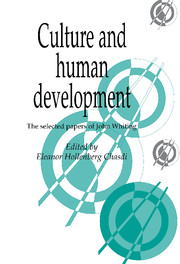Book contents
- Frontmatter
- Contents
- List of figures
- Preface
- Acknowledgments
- Introduction: John Whiting and anthropology
- Fifty years as a behavioral scientist: autobiographical notes
- Part I Theory and methods
- Part II Environment and history
- Part III Moral development
- Part IV Gender development
- Introduction
- 8 The absent father and cross-sex identity
- 9 Effects of climate on certain cultural practices
- 10 Male sex-role resolutions
- Part V Development of social behavior
- Bibliography
- Complete bibliography of John W. M. Whiting's work
- Index
10 - Male sex-role resolutions
Published online by Cambridge University Press: 23 December 2009
- Frontmatter
- Contents
- List of figures
- Preface
- Acknowledgments
- Introduction: John Whiting and anthropology
- Fifty years as a behavioral scientist: autobiographical notes
- Part I Theory and methods
- Part II Environment and history
- Part III Moral development
- Part IV Gender development
- Introduction
- 8 The absent father and cross-sex identity
- 9 Effects of climate on certain cultural practices
- 10 Male sex-role resolutions
- Part V Development of social behavior
- Bibliography
- Complete bibliography of John W. M. Whiting's work
- Index
Summary
Among the cultures of the world, there are two widespread institutions that deal with defining or affirming appropriate behavior for adult males – male initiation rites at puberty and the couvade. The type of male initiation to be considered in this chapter consists of a series of rites during which the initiate is transformed from a genderless child to an adult male. Ritual circumcision begins the sequence, followed by a period of exclusion from domestic life, and completed by a ceremony of reentry into the domestic and reproductive cycle. The couvade, sometimes termed “male childbed” because of the husband's involvement in the birth process, is a set of supernaturalistic observances on the part of the father of a newborn or to-be-born child. The observances in their intensive form (the focus of interest in this paper) require the father to deviate significantly from normal activities (Munroe, Munroe, and Whiting 1973).
Male initiation rites
There are a number of initiation rites for males that, since they do not focus on sex gender, will not be considered in this chapter. Such rites may focus on the responsibilities of adult status (Schlegel and Barry 1975; Granzberg 1972, 1973); others are intended to introduce the novice to the supernatural world (Eliade 1965); still others signal a transition from an ignorant child to an adult scholar. This chapter will be concerned with that set of rites that includes circumcision and that are defined by the culture as necessary for the attainment of adult male status.
- Type
- Chapter
- Information
- Culture and Human DevelopmentThe Selected Papers of John Whiting, pp. 237 - 262Publisher: Cambridge University PressPrint publication year: 1993



